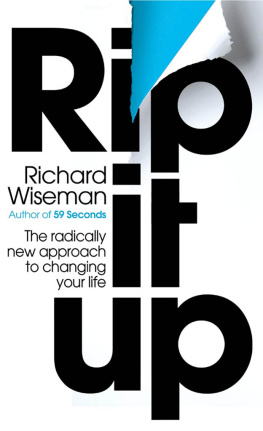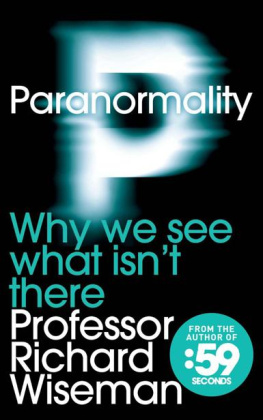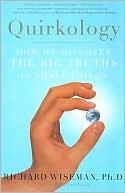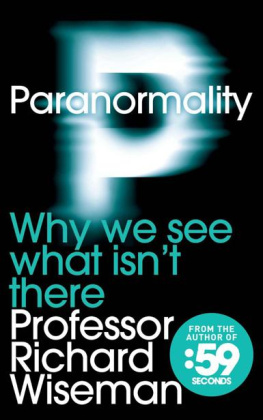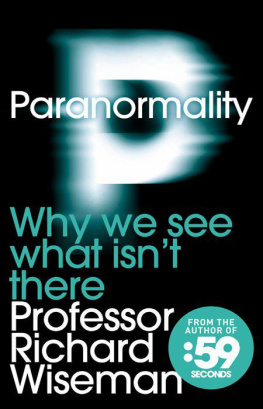
To Ronald and Brenda

If you want a quality, act as if you already have it
Philosopher, William James, 1884
A Brief Introduction
Its time to Rip It Up
Self-help gurus and business coaches preach the same simple mantra: If you want to improve your life then you need to change how you think. Force yourself to have positive thoughts and you will become happier. Visualize your dream self and you will enjoy increased success. Think like a millionaire and you will magically grow rich. In principle, this idea sounds perfectly reasonable. However, in practice the approach often proves surprisingly ineffective, with research showing that people struggle to continually think happy thoughts, that employees remain unmoved by imagining their perfect selves, and that those dreaming of endless wealth fail to make their millions.
Over a century ago the brilliant Victorian philosopher William James proposed a radically different approach to change. Since then researchers from across the world have carried out hundreds of experiments into Jamess theory and discovered that it applies to almost every aspect of peoples lives. Perhaps most importantly of all, the work has given rise to a series of easy and effective exercises that can help people feel happier, avoid anxiety and worry, fall in love and live happily ever after, stay slim, increase their willpower and confidence, and even slow the effects of ageing. This research has been presented at countless scientific conferences and published in academic journals, but has rarely made its way into the public domain.
In my previous book, 59 Seconds, I described a handful of these exercises. Rip It Up builds on this work by presenting the first accessible and comprehensive guide to Jamess radical theory. It reveals how everything you currently believe about your mind is wrong, shows that change does not have to be challenging, and describes a series of easy-to-implement techniques that are designed to improve several different areas of your everyday life.
Throughout the book you are going to be asked to change your behaviour. To emphasize this key message I am going to invite you to do something that I suspect you have never done before. I would like you to destroy parts of this book as you work your way through it. I suspect that there are two possible thoughts running through your mind at the moment.
First, you might be thinking something along the lines of Noooooooooooooo, I hate the idea of ripping up my book! That, of course, is the point of the exercise. Ask someone to alter their behaviour and they will quickly produce a long list of reasons why they should continue to act in the same old way. This attitude is perhaps understandable (after all, behaviours quickly become ingrained in our minds and soon start to feel like old friends), but it presents perhaps the biggest barrier to change. The most effective way of overcoming this problem is simply to do something that you have never done before. Something that makes you feel rather uncomfortable but is harmless. Like destroying a book.
Second, if you are looking at this on an ebook reader then you will realize that you obviously cant carry out the exercise. Thats fine. Simply find a self-help book that encourages you to change the way you think and destroy that instead. Just kidding. Actually, please visit www.RipItUp.biz, download a copy of the Rip It Up workbook, and print it out. This workbook contains everything you will need to join in with the interactive exercises.
To help get the ball rolling, lets start with a small act of radical change. The following page contains a picture of The Rule Book. Please rip out the page right now, tear The Rule Book into four pieces, and screw each of the pieces into a paper ball. Hopefully that wasnt too painful, and you felt your mind undergo a small but real change. I hope that you enjoyed the exercise because throughout the book I am going to ask you to alter many other aspects of your behaviour and, each time, experience much more significant and important shifts in your thoughts and feelings.
Its time to embrace a new approach to change. An approach that is grounded in science, overturns conventional thinking, and provides a basis for the easiest, quickest and most effective ways of changing your life.
So sit up straight, take a deep breath and prepare to Rip It Up.

1. HOW TO BE HAPPY
Where we meet that adorable genius William James, turn the world upside down, learn how to create good cheer at will, and visit the fun factory.
In the Beginning Was the Deed.
Faust, Johann Wolfgang von Goethe
1. THE SIMPLE IDEA THAT CHANGES EVERYTHING
The worlds first laboratory-based psychology experiment was carried out by the German psychologist Professor Wilhelm Wundt in 1879. This historic study was conducted in a small room at the University of Leipzig, and reveals all you need to know about how Victorian scientists approached the human mind.
Wundt could have celebrated the birth of experimental psychology by investigating any fascinating topic of his choosing. Perhaps why people fall in love, believe in God, or sometimes feel the need to kill one another. Instead, the humourless and indefatigable Wundt chose to conduct a strange and bizarre experiment involving a small brass ball.
Wundt and two of his students gathered around a small table and connected together a timer, a switch, and a carefully designed metal stand. A brass ball was then balanced on the stand and one of Wundts students placed his hand a few millimetres above the switch. Seconds later the ball was automatically released from the stand and the timer sprang into action. The student slammed his hand down on the switch the moment that he heard the brass ball hit the table, which immediately halted the timer. By carefully recording the reading shown on the timer in his notebook, Wundt created psychologys first data point.
It would be nice to think that after a day or so of ball-dropping Wundt would have closed his notebook, reported his findings and moved on to something more interesting. Nice, but wrong. In fact, he spent the next few years of his life observing hundreds of people responding to the test. In the same way that physicists were trying to identify the fundamental nature of matter, so Wundt and his team were attempting to discover the fundamental building blocks of consciousness. Some of the participants were asked to press the switch the moment they first heard the ball hit the table, whilst others were told to react when they became fully aware of the sound. In the first scenario the observer was asked to concentrate their attention on the ball, whilst in the second instance they were required to focus more on their own thoughts. When the tasks were performed properly, Wundt believed that the first reaction would represent a simple reflex whereas the second involved more of a conscious decision. Perhaps not surprisingly, many participants initially struggled to recognize the alleged subtle difference between the two conditions, and so were required to complete more than ten thousand trials before moving on to the experiment proper.
After carefully wading through the resulting mass of ball-dropping data, Wundt concluded that the reflexive response took an average of one tenth of a second and left the participants with a very weak mental record of the sound of the ball. In contrast, consciously hearing the sound produced an average reaction time of two tenths of a second and resulted in a far clearer experience of the balls impact.
Next page
